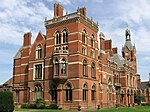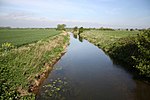Staythorpe Power Station
Buildings and structures in NottinghamshireEnergy infrastructure completed in 2010Natural gas-fired power stations in EnglandPages with disabled graphsPower stations in the East Midlands ... and 2 more
Proposed natural gas-fired power stationsRWE

Staythorpe C Power Station is a 1,735 MWe gas-fired power station at Staythorpe between Southwell and Newark-on-Trent in Nottinghamshire, England, between the River Trent and Nottingham to Lincoln railway line. The station was handed over to the owner RWE from Alstom Power with full commercial operation being achieved in December 2010. The official opening ceremony attended by Charles Hendry, Minister of State took place on 9 May 2011.The £680 million plant is owned by the German energy company, RWE. It is the second largest Combined Cycle Gas Turbine (CCGT) power station in the UK and has an overall efficiency in excess of 58%.
Excerpt from the Wikipedia article Staythorpe Power Station (License: CC BY-SA 3.0, Authors, Images).Staythorpe Power Station
Long Lane, Newark and Sherwood Farndon
Geographical coordinates (GPS) Address Nearby Places Show on map
Geographical coordinates (GPS)
| Latitude | Longitude |
|---|---|
| N 53.07482 ° | E -0.85573 ° |
Address
Staythorpe Power Station Car Park
Long Lane
NG23 5PS Newark and Sherwood, Farndon
England, United Kingdom
Open on Google Maps








